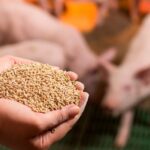You may ask if fumaric acid is natural or artificial. Fumaric acid is found in nature. It is in some fruits and vegetables. Your body also makes fumaric acid during metabolism. But most fumaric acid in food or supplements is made in factories. Both natural and synthetic types have the same chemical structure. They also work the same way.
What Is Fumaric Acid?
Fumaric Acid: Definition and Key Traits
You might ask what makes fumaric acid special. This compound is an organic acid. You can find it in some foods and inside your body. Scientists also call it trans-2-butenedioic acid. It has a simple shape, but it does many important jobs.
Here is a table that gives the main chemical facts about fumaric acid:
| Property | Information |
|---|---|
| Molecular Formula | C4H4O4 |
| Synonyms | Trans-2-Butenedioic Acid |
| Molecular Weight | 116.07 |
| Chemical Structure | trans-2-butenedioic acid |
Fumaric acid is different because of its trans (E) shape. This means the two carboxylic acid groups are on opposite sides of a double bond. This shape makes the molecule more stable and gives it a high melting point. Fumaric acid is a white, solid powder. It has a slightly fruity smell. It does not mix well with cold water, but it mixes better with hot water. Fumaric acid does not soak up water easily and can handle heat. This makes it useful in many products.
Tip: Fumaric acid is more stable than maleic acid because of its special shape.
Fumaric Acid in Human Metabolism
Your body uses fumaric acid in an important way. It is a key part of the Krebs cycle. This is how your cells make energy. When your cells break down food, they make fumaric acid as one step. An enzyme called succinate dehydrogenase helps make fumaric acid. This step also helps your cells get energy.
Fumaric acid does more than help with energy. It can also send signals in your body. It can change how your genes work by affecting gene methylation. This means fumaric acid can help control how your cells grow and deal with stress. Scientists found that changes in fumaric acid levels can affect your immune system. It may also play a part in some diseases, like cancer and autoimmune disorders.
Natural Sources of Fumaric Acid
Fruits and Vegetables That Naturally Contain Fumaric Acid
Fumaric acid is in many foods you eat. This compound is found in some fruits and vegetables. It gives some foods a sour taste. Here are some foods with fumaric acid:
- Apples
- Grapes
- Berries
- Tomatoes
- Carrots
These foods use fumaric acid for their special flavor. You might taste a little sourness when you eat them. The amount of fumaric acid in these foods is very small. Scientists studied many plants and saw the levels stay low, even when plants are stressed. You do not have to worry about eating too much from these foods.
Note: Fumaric acid is safe to eat in the small amounts in fruits and vegetables.
Other Natural Sources of Fumaric Acid in the Environment
Fumaric acid is also found outside of food. Some fungi in nature make this acid as they grow. Fungi like Rhizopus and Aspergillus make fumaric acid in the soil. These fungi change the soil by giving off organic acids. This helps plants get nutrients and can clean up metals in the ground.
- Fungi such as Rhizopus, Aspergillus, and Penicillium are main producers of fumaric acid in soil.
- These fungi help keep the soil’s pH balanced and help plants grow.
- Soil bacteria live there too, but fungi make most of the fumaric acid.
Both plants and fungi help make fumaric acid. These natural sources keep the environment healthy and help many living things.
Synthetic Fumaric Acid: Production and Uses
Synthetic Fumaric Acid: Production Methods
You might wonder how companies make most fumaric acid for foods. Even though fumaric acid is found in nature, almost all of it is made in factories. Factories use a few main ways to make it in large amounts.
- The most common way starts with maleic anhydride. Factories change this chemical by adding oxygen. Then they use heat and special helpers like phosphoric acid or sodium hydroxide. This changes the shape of the molecule. It goes from the cis-form (maleic acid) to the trans-form, which is fumaric acid.
- Another way uses heat or special helpers called catalysts. Maleic acid turns into fumaric acid with help from mineral acids or metal helpers.
- Some companies use living things like fungi. They grow fungi such as Rhizopus or Aspergillus on sugars or plant leftovers. The fungi turn the sugars into fumaric acid by fermentation. This way is getting more popular because it uses things that can be replaced and makes less pollution.
Note: Making fumaric acid from oil has been the main way for a long time because it is cheap and easy. But now, more companies are trying fermentation to help the planet.
People have made synthetic fumaric acid for over 100 years. Scientists first made it by fermentation in 1910. By the 1940s, companies like Pfizer made lots of it using fungi. In the 1970s, chemical ways became more common because they cost less. Today, higher oil prices and worries about the environment are making fermentation popular again.
Chemical Identity: Comparing Natural and Synthetic Fumaric Acid
You might ask if natural and synthetic fumaric acid are different. The answer is no. Both have the same formula, C4H4O4. Each one has a double bond and two carboxylic acid groups. The shape is always the trans-isomer, which makes it stable and useful.
No matter how you make it, the final product is the same. Your body and food cannot tell them apart. Both types work the same way in foods, drinks, and your cells.
Tip: How you make fumaric acid does not change how safe it is or how it works in your body.
Main Uses of Synthetic Fumaric Acid
Synthetic fumaric acid is used in many things you use every day. You can find it in foods, drinks, and many products.
- In food, it helps control sourness, adds flavor, and keeps food fresh. It also helps baked goods rise. You can find it in:
- Baked goods like bread, cakes, and sourdough
- Candy and sour treats
- Dairy foods like yogurt, chocolate milk, and cheese
- Jams, jellies, and sauces
- Snack foods and cereals
- Processed meats and spreads
- Drinks like instant mixes, wine, and spirits
- Fumaric acid is used to make strong plastics called unsaturated polyester resins. These are used in cars, boats, buildings, and paints. The acid helps make these things strong and last longer.
- In baking, it helps dough rise by reacting with baking soda.
- It makes bread softer and easier to cut.
- In factories, fumaric acid helps make special paints and coatings.
Here is a table that compares fumaric acid with other food acids:
| Acidulant | Main Function | Shelf Life Extension | Food Applications | Environmental Impact |
|---|---|---|---|---|
| Fumaric Acid | Acidulant, antimicrobial, antioxidant | Moderate to long-term | Beverages, dairy, sauces, jams, pickles | Low, biodegradable |
| Citric Acid | Acidulant, preservative | Moderate | Beverages, candies, canned goods | Low, biodegradable |
| Ascorbic Acid | Antioxidant, preservative | Short to moderate | Juices, fruits, snacks, canned foods | Moderate, depends on production |
| Sodium Benzoate | Antimicrobial, preservative | Long-term | Beverages, sauces, canned foods | Moderate, can be toxic at high levels |
| Calcium Propionate | Antifungal, preservative | Long-term | Bread, bakery products | Moderate, synthetic |
Fumaric acid is special because it tastes very sour, lasts a long time, and does not soak up water. This makes it great for dry mixes and foods that stay on shelves. It also helps stop germs from growing in food.
Callout: Synthetic fumaric acid is safe, works well, and is approved by food safety groups around the world.
Safety and Dietary Suitability
Fumaric Acid: Food Safety and Regulation
You do not need to worry about the safety of fumaric acid in food. Groups like the US FDA and EFSA make rules for how it is used. The FDA says fumaric acid is generally recognized as safe (GRAS). You can eat up to 10 mg for each kilogram you weigh every day. EFSA also allows fumaric acid as a food additive and uses the same daily limit.
Groups like the FDA, EPA, and EFSA check that synthetic fumaric acid is pure and safe. They make companies test and check their products carefully. These rules help keep your food safe and clean. Agencies change their rules often, so companies must keep making their products better. Many companies now use greener ways, like bio-fermentation, to help the environment.
You might wonder if fumaric acid is safe for kids or pregnant women. Studies show it does not harm these groups. Fumaric acid is safe for foods for children and pregnant women. If you want to eat a lot of it for a long time, talk to a doctor first.
Some people may get side effects from medicines with fumaric acid. This happens most with psoriasis or multiple sclerosis treatments. Side effects can be stomach pain, diarrhea, nausea, or flushing. Most side effects stop when you stop the medicine. Serious problems with kidneys or liver are rare and usually go away. Doctors check patients often to stop problems before they get worse.
Tip: Fumaric acid is stronger than other food acids, so you only need a little bit.
Here is a table that shows how agencies check fumaric acid:
| Aspect | Description |
|---|---|
| Safety Agencies | FDA, EPA, EFSA |
| Monitoring | Strict food safety standards and regular updates |
| Compliance | Rigorous testing and quality assurance |
| Sustainable Practices | Promotion of greener production methods |
| Risk Mitigation | Ongoing engagement with regulatory changes |
| Outcome | Ensures safety, purity, and quality of fumaric acid in food products |
Suitability of Fumaric Acid for Vegan, Halal, Kosher, and Gluten-Free Diets
You may want to know if fumaric acid fits your diet. Fumaric acid comes from plants and fungi. Companies make it by letting tiny living things turn sugars into fumaric acid. No animal parts are used. This means fumaric acid is okay for vegan diets.
Groups that give halal and kosher labels say fumaric acid is allowed. You can find foods with these labels that have fumaric acid. It is also common in gluten-free foods. If you cannot eat gluten, you can still eat foods with fumaric acid.
- Fumaric acid is vegan-friendly.
- It meets halal and kosher rules.
- It is gluten-free.
You will see fumaric acid in many foods like bread, candy, and drinks. It helps make food taste better, last longer, and keeps the right sourness. You can trust that fumaric acid is safe for most diets.
Note: Fumaric acid is good for vegan, halal, kosher, and gluten-free diets. You can eat foods with fumaric acid without worry.
You have learned that fumaric acid can be natural or made in factories. Both kinds have the same shape and work the same way in food and your body. Fumaric acid is safe for most people and most diets. Many companies make synthetic fumaric acid because it is cheap and good quality. Some new ways to make it are better for the planet and use cleaner methods. No matter how it is made, fumaric acid always works the same.
FAQ
Is fumaric acid safe to eat every day?
You can safely eat foods with fumaric acid every day. Food safety groups like the FDA and EFSA check it. They set limits to keep you safe. Most people eat much less than the allowed amount.
Does fumaric acid come from animals?
No, fumaric acid does not come from animals. Factories make it from plants, fungi, or chemicals. You can eat it if you follow a vegan, halal, or kosher diet.
Why do companies add fumaric acid to food?
Companies add fumaric acid to food to give a sour taste, keep food fresh, and help baked goods rise. It also helps stop germs from growing in food.
Can you taste fumaric acid in food?
You might notice a sour or tart flavor in foods with fumaric acid. It is stronger than citric acid, so you only need a little to taste it.




